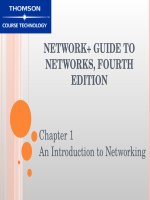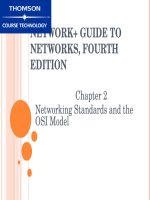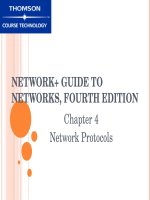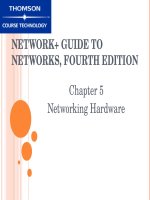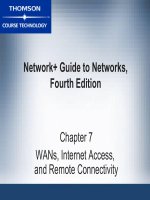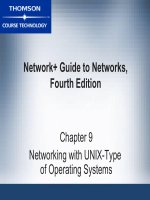Guide to network essentials 4th chapter 04
Bạn đang xem bản rút gọn của tài liệu. Xem và tải ngay bản đầy đủ của tài liệu tại đây (593.04 KB, 34 trang )
Chapter 4:
Network Interface Cards
Learning Objectives
Describe the role a network adapter card plays in
networked communications
Explain how network adapters prepare data
for transmission, accept incoming network traffic, and
control how networked communications flow
Understand the variety of configurable options
for network adapters, and describe common settings
Guide to Networking Essentials,
2
Learning Objectives (continued)
Describe important characteristics for selecting adapter
cards
Recount network adapter enhancements that can improve
performance
Explain the role of driver software in network adapters
Guide to Networking Essentials,
3
Network Interface Card (NIC) Basics
Plugs into expansion slot
Provides physical interface between computer and
network medium
Performs two crucial tasks
Establishes and manages computer’s network
connection
Translates data into signals for outgoing messages
and translates signals for incoming messages
Guide to Networking Essentials,
4
From Parallel to Serial, and Vice Versa
Most computers use parallel data lines, called a bus, to
send data between CPU and adapter cards
Most networking media transmits data in single line,
called serial transmission
NIC translates parallel into serial for outgoing messages
and serial into parallel for incoming messages
See Figure 4-1
Guide to Networking Essentials,
5
NIC Allows the Computer and the Network
Cable to Communicate
Guide to Networking Essentials,
6
Understanding the Bus
Bus width refers to number of parallel lines, each able to
move one bit at a time
Industry Standard Architecture (ISA) has
an 8- or 16-bit bus
Later 32-bit and 64-bit buses were introduced
The 64-bit Peripheral Component Interconnect
(PCI) is fastest and most popular bus today
Guide to Networking Essentials,
7
Transceiver
Designed for specific medium
NIC accesses transceiver to transmit data
Some NICs include transceiver
Ethernet can use variety of media
Some Ethernet NICs offer multiple interfaces
See Figure 4-2
Newer NICs have only one type of media connector
Guide to Networking Essentials,
8
Ethernet NIC
Guide to Networking Essentials,
9
NICs and Packets
Packets are basic unit of data for network transmission
and reception
NICs create packets of bits
Transmit packets serially onto network medium
Act as gatekeeper, allowing only inbound packets
intended for its computer
Guide to Networking Essentials,
10
MAC Address
NIC has unique identifier, called Media Access Control
(MAC) address
Programmed into ROM chip
48-bit number, written as six two-digit hexadecimal
numbers separated by colons
First part identifies manufacturer
Second part unique to each NIC
Guide to Networking Essentials,
11
PC Buses
Industry Standard Architecture (ISA) uses
8- or 16- bit bus with top speed of 10 MHz – essentially
obsolete
Extended Industry Standard Architecture (EISA)
offers 32-bit bus – obsolete
Micro Channel Architecture (MCA) is IBM’s proprietary
32-bit bus with speeds up
to 66 MHz – largely obsolete
Guide to Networking Essentials,
12
PC Buses (continued)
Peripheral Component Interface (PCI) is newest 64-bit
version of high-speed local bus; PCI 2.0 moved PCI from
being a local bus, tied to the CPU, to a microprocessorindependent bus that can be used with any
manufacturer’s CPU
PCI-X – PCI-X 2.0, is backward compatible to PCI, but
supports speeds from 66 MHz to 533 MHz, providing
data transfers from 500 MBps to 4.3; this high speed
accommodates Gigabit and 10 Gigabit Ethernet and
high-speed disk controllers (such as Ultra3 SCSI and
10Gb Fibre Channel)
Guide to Networking Essentials,
13
PC Buses (continued)
Developing bus standards – Currently in development
is a serial-based bus called PCI Express (formerly
named 3GIO)
Will likely operate at speeds from 2.5 Gbps to 10
Gbps
Because PCI Express can be set up in lanes, several
lanes can be combined to provide tremendous
transfer speeds
Speeds are expected to reach 5 GBps and beyond
Guide to Networking Essentials,
14
PC Buses (continued)
Guide to Networking Essentials,
15
Other PC Interfaces Used
for Networking
Universal Serial Bus (USB) is serial
interface for low-speed peripheral devices
FireWire (IEEE 1394) is high-speed serial bus with
bandwidth up to 400 Mbps used
for digital cameras and video devices
New version, 1394b, supports transfers up to
3200 Mbps
Guide to Networking Essentials,
16
Principles of NIC Configuration
Match NIC to slot on PC or external connection such as
USB
Plug and Play usually configures NIC recognized by
power-on self-test (POST)
If necessary, manually configure NIC
NIC configuration involves three settings:
Interrupt Request line (IRQ)
Base I/O port
Base memory address
Guide to Networking Essentials,
17
Making the Network Attachment
NIC performs several roles:
Establishes physical link to networking medium
Generates signals that traverse networking medium
Receives incoming signals
Implements controls that determine when signals
transmit to or are received from network medium
Connections on NIC determine media type
May need to set jumpers or DIP switches to
select media used
Guide to Networking Essentials,
18
Choosing Network Adapters for Best
Performance
NICs affect network performance
Consider several enhancements that can
affect speed and data-handling capabilities:
Direct Memory
Access (DMA)
Shared adapter
memory
Shared system
memory
Bus mastering
RAM buffering
Guide to Networking Essentials,
On-board
co-processors
Security features
Traffic management
Fault tolerance
Improved management
features
19
Choosing Network Adapters for Best
Performance (continued)
Purchasing checklist for network interface cards:
Bus width (16-bit is slower than 32-bit; pick PCI or PCIX)
Bus type (pick 64-bit PCI-X for servers whenever
possible)
Memory transfer (shared memory outpaces I/O or DMA)
Special features required (security, management,
protocol handling, hot-plug capable)
Bus mastering (important for servers)
Vendor factors (quality, reliability, staying power,
reputation)
Guide to Networking Essentials,
20
Special-Purpose NICs
Several type of NICs deliver specialized capabilities
Wireless Adapters
Remote Boot Adapters
Guide to Networking Essentials,
21
Wireless Adapters
Include some or all of these components:
Indoor antenna and antenna cable
Software to enable adapter to work with particular network
environment
Diagnostic software to check installation or troubleshoot
Installation software
Remote Boot Adapters
Used with wireless access point to add wireless devices
to existing wired network
Keep in mind the standard you need: 802.11a, 802.11b,
802.11g
Guide to Networking Essentials,
22
Remote Boot Adapters
Diskless workstations boot up by reading information
from disk
NIC has Boot PROM (programmable read-only memory)
that is PXE (pre-boot execution environment) compliant
Includes hardwired code to start computer and access
the network
Advantages of remote boot adapters include cost saving,
better reliability, and increased security
Guide to Networking Essentials,
23
Driver Software
NIC requires software device driver
Small specialized program that manages
communications between operating system
and NIC
Poorly written or incorrect drivers may prevent
PC from booting or may have detrimental impact on
network performance
Earlier, each NIC vendor built its own driver
Now, operating system vendors define drivers
Guide to Networking Essentials,
24
Driver Software (continued)
Three major vendor standards for drivers:
Network Device Interface Specification (NDIS)
defines interface between MAC sublayer and
NIC driver; lets NIC use multiple protocols
Win32 Driver Model (WDM) defines interface
for PCs with modern Windows operating
systems; improves driver quality by dividing drivers by
function
Open Data-link Interface (ODI) defined by Apple and
Novell allows NIC to use multiple protocols
Guide to Networking Essentials,
25

